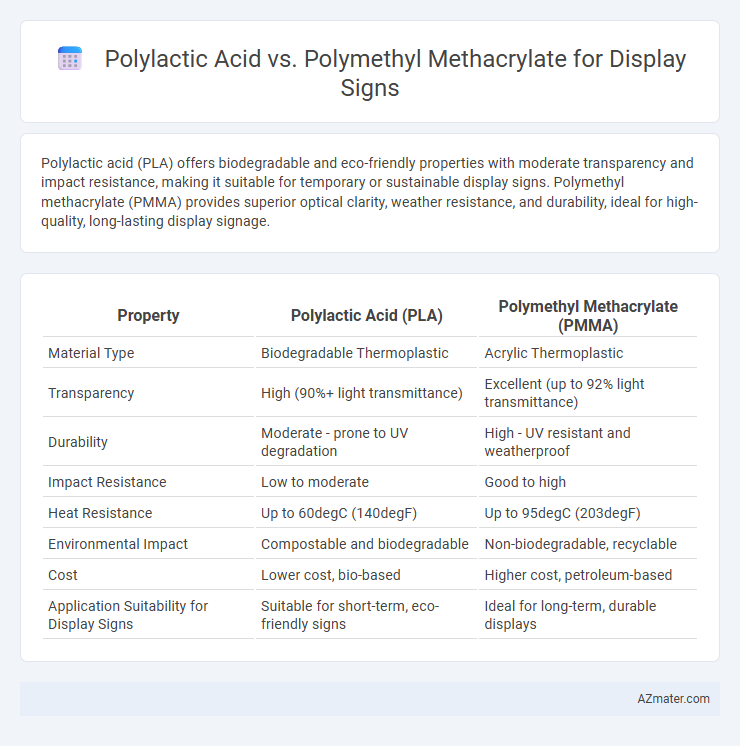Polylactic acid (PLA) offers biodegradable and eco-friendly properties with moderate transparency and impact resistance, making it suitable for temporary or sustainable display signs. Polymethyl methacrylate (PMMA) provides superior optical clarity, weather resistance, and durability, ideal for high-quality, long-lasting display signage.
Table of Comparison
| Property | Polylactic Acid (PLA) | Polymethyl Methacrylate (PMMA) |
|---|---|---|
| Material Type | Biodegradable Thermoplastic | Acrylic Thermoplastic |
| Transparency | High (90%+ light transmittance) | Excellent (up to 92% light transmittance) |
| Durability | Moderate - prone to UV degradation | High - UV resistant and weatherproof |
| Impact Resistance | Low to moderate | Good to high |
| Heat Resistance | Up to 60degC (140degF) | Up to 95degC (203degF) |
| Environmental Impact | Compostable and biodegradable | Non-biodegradable, recyclable |
| Cost | Lower cost, bio-based | Higher cost, petroleum-based |
| Application Suitability for Display Signs | Suitable for short-term, eco-friendly signs | Ideal for long-term, durable displays |
Introduction: Importance of Material Choice for Display Signs
Selecting the right material for display signs directly impacts durability, visibility, and environmental sustainability. Polylactic acid (PLA) offers biodegradable properties and clarity suitable for eco-friendly signage, while polymethyl methacrylate (PMMA) delivers superior impact resistance and optical clarity for high-performance displays. Understanding these material characteristics optimizes sign lifespan and visual appeal in diverse application environments.
Overview of Polylactic Acid (PLA) and Polymethyl Methacrylate (PMMA)
Polylactic Acid (PLA) is a biodegradable thermoplastic derived from renewable resources like corn starch or sugarcane, known for its eco-friendly properties and ease of processing in 3D printing and display applications. Polymethyl Methacrylate (PMMA), commonly known as acrylic, is a durable, transparent thermoplastic with excellent optical clarity and weather resistance, making it ideal for long-lasting display signs. PLA offers sustainability and lower environmental impact, while PMMA provides superior strength, UV stability, and scratch resistance for high-performance signage.
Material Properties Comparison: PLA vs PMMA
Polylactic acid (PLA) offers biodegradability and a lower environmental impact compared to polymethyl methacrylate (PMMA), making it suitable for eco-friendly display signs. PMMA exhibits superior optical clarity, higher impact resistance, and greater weatherability, ensuring durability and vibrant visibility in outdoor signage applications. Both materials present distinct advantages: PLA excels in sustainability, while PMMA provides enhanced mechanical strength and long-term performance for display signs.
Durability and Weather Resistance
Polylactic acid (PLA) offers moderate durability and biodegradability but exhibits lower weather resistance, making it less ideal for long-term outdoor display signs exposed to UV radiation and moisture. Polymethyl methacrylate (PMMA), known as acrylic, provides superior durability and excellent weather resistance, maintaining clarity and structural integrity under prolonged sun exposure and harsh environmental conditions. For display signage requiring long-term outdoor use, PMMA outperforms PLA in maintaining visual appeal and material strength.
Visual Clarity and Aesthetic Appeal
Polylactic acid (PLA) offers excellent visual clarity with a natural gloss and smooth surface, making it ideal for eco-friendly display signs that require vibrant color reproduction. Polymethyl methacrylate (PMMA), commonly known as acrylic, provides superior optical transparency with up to 92% light transmission and a high-gloss finish, enhancing aesthetic appeal and durability for premium signage. While PLA is biodegradable and sustainable, PMMA delivers better scratch resistance and long-term visual clarity, making it preferred for high-end or outdoor displays.
Ease of Fabrication and Processing
Polylactic acid (PLA) offers ease of fabrication for display signs due to its lower melting point and compatibility with standard 3D printing and thermoforming techniques, enabling cost-effective and rapid prototyping. Polymethyl methacrylate (PMMA), known for its superior clarity and durability, requires more precise thermal processing and specialized equipment for cutting and molding, which can increase production complexity and costs. While PLA processes faster with less energy, PMMA's enhanced mechanical strength and resistance to UV degradation make it preferable for long-lasting, high-quality display signs.
Environmental Impact and Sustainability
Polylactic acid (PLA) offers a significant environmental advantage over polymethyl methacrylate (PMMA) for display signs due to its biodegradability and origin from renewable resources like corn starch, reducing reliance on fossil fuels. PMMA, although durable and clear, is derived from petrochemicals and is non-biodegradable, leading to long-term environmental persistence and challenges in waste management. Choosing PLA enhances sustainability by enabling compostable signage solutions that minimize ecological footprints and support circular economy principles.
Cost Efficiency and Budget Considerations
Polylactic acid (PLA) offers a cost-effective alternative for display signs due to its lower raw material price and biodegradability, reducing long-term waste management expenses. Polymethyl methacrylate (PMMA) typically involves higher upfront costs but provides superior durability and optical clarity, potentially lowering replacement frequency and maintenance expenses. Budget considerations should weigh PLA's affordability and environmental benefits against PMMA's performance longevity and premium visual quality for optimal cost efficiency.
Suitability for Indoor vs Outdoor Applications
Polylactic acid (PLA) offers excellent biodegradability and is best suited for indoor display signs due to its lower UV resistance and reduced durability under prolonged outdoor exposure. Polymethyl methacrylate (PMMA) provides superior weather resistance, UV stability, and impact strength, making it ideal for outdoor signs that require long-lasting clarity and color retention. Choosing between PLA and PMMA depends on environmental exposure, with PLA favored for eco-friendly indoor use and PMMA preferred for robust outdoor applications.
Conclusion: Best Material for Display Signage
Polylactic acid (PLA) offers eco-friendly, biodegradable properties and good print clarity, making it suitable for temporary or sustainable display signs. Polymethyl methacrylate (PMMA) provides superior durability, UV resistance, and scratch resistance, ideal for long-lasting, high-quality display signage. For the best overall material in display signs, PMMA is preferred due to its enhanced strength and weather resistance, ensuring longevity and visual appeal.

Infographic: Polylactic acid vs Polymethyl methacrylate for Display Sign
 azmater.com
azmater.com